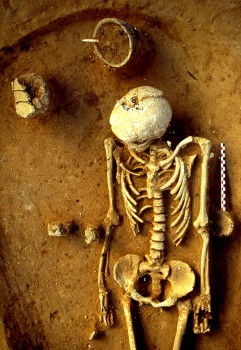The aim of this project is to reveal the forms and extent of social diversity among the earliest farmers of central Europe, in order to provide new avenues to investigate the history of social inequality.
The project will characterise social diversity across nearly a millennia in the Neolithic of central Europe, analysing how diet, mobility and health, as proxies for lifeways, varied in time and between different individual, cemeteries, settlements and cultural groups. It will then build on these data to ask what are the principal characteristics of Neolithic social diversity (age, sex, social group, or culture), and what was the history of Neolithic social inequality, does it increase, decrease or persist through time?
Social inequality and diversity in the Neolithic
Previous descriptions of Neolithic societies have relied on evidence from rich burials and ritual sites to model the form of the elite within society (e.g. 'Big Man' models). By focusing only on the elite these models produce a narrow, biased and binary picture of social standing in the past. In contrast, this project will employ bioarchaeological methods to assess lifeway diversity across the full range of social groups, rather than just those of the elite. At stake is whether diversity increases, decreases or persists from the early Neolithic to the middle Neolithic.
Regional Focus
The project will take as its focus the Early and Middle Neolithic in Alsace (c.5300-4300 cal BC). The Alsace region now has a high resolution and precise chronology for the period under study (Denaire et al. 2017) and offers plenty of house plans.
Methodologies

Outcomes
Our results will be disseminated via open access journal articles, conference presentations, a website with blog, associated social media, and downloadable resources and events for the public and interest groups. The project will benefit the scholarly study of the Neolithic, and of the history of social inequality more broadly. Its application in events and resources for children and local communities will aid the effort to improve understanding of the complex experience of social diversity in today's world of growing social inequality, global mobility and culture contact.
Our results will be disseminated via open access journal articles, conference presentations, a website with blog, associated social media, and downloadable resources and events for the public and interest groups. The project will benefit the scholarly study of the Neolithic, and of the history of social inequality more broadly. Its application in events and resources for children and local communities will aid the effort to improve understanding of the complex experience of social diversity in today's world of growing social inequality, global mobility and culture contact.
References
Denaire, A., Lefranc, P., Wahl, J., Bronk Ramsey, C., Dunbar, E., Goslar, T., Bayliss, A., Beavan, N., Bickle, P. and Whittle, A. 2017. The cultural project: formal chronological modelling of the early and middle Neolithic sequence in Lower Alsace, Journal of Archaeological Method and Theory, 24, 1072–1149. Open Access, available here: https://doi.org/10.1007/s10816-016-9307-x







